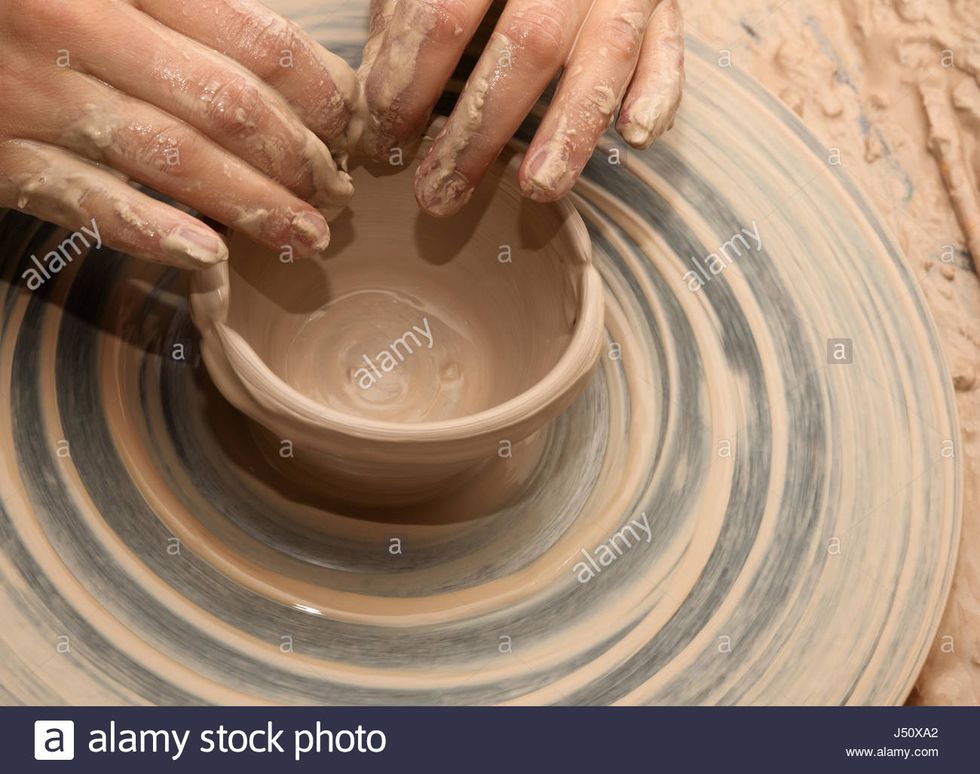Art is something I always found fascinating. I don't find myself particularly creative, but I have always admired those who are. My best friend studies art, and I find her work to be amazing. Where do these ideas stem from, and how does one encapsulate so much into one piece of art? Rather than painting or drawing, I thought working with clay was really neat because one can not only design his or her own work, but also abstractly create the piece's ultimate design. I love learning about clay, and from my friend, I have learned a lot about clay making!
Clay is a natural rock or soil mixture. It combines with other clay mixtures found in nature, such as metal oxides and organic materials in the earth. Clay can be found anywhere in the world, especially areas where water can be found after a heavy rain around soil. Clays are different colors because of the different content of soils and the different areas of the earth that they are found in. The four main types of clay used by the potter are Earthenware clays, Stoneware clays, Mid-Fire Stoneware clays, and High-Fire Stoneware clays. The Earthenware is the most common clay found and is the oldest known. It is highly plastic and sticky. The Stoneware is plastic and typically gray when moist. When fired, their colors range from brown to gray and the type of firing can influence the outcome of the color greatly. Mid-Fire are made to be fired in 2150 to 2260 degrees Fahrenheit and High-Fire are meant to be fired in 2200 to 2336 degrees Fahrenheit. Porcelain clays often have the highest firing temperatures. In high school, I took an art class, and we used Mid-Fire Range because of its ability to be fired, but not to the extreme temperatures, and Earthenware because it is very commonly used in art classes.
There is many techniques when it comes to hand building. One is known as pinch, a method of shaping clay by inserting the thumb of one hand into the clay and lightly pinching with the thumb and fingers while slowly rotating the ball of clay in your other hand. Coil is building ceramic forms by rolling out rolls of coils, or ropes of clay, and then joining them together with your fingers. Slip is used for liquid clay and takes place when a person uses sift or dry clay into a cup of water. It is important to stir well as water is added because it tends to thicken up quickly. Score and slip occurs when two pieces of clay are joined together. First, the clay is scored, when the scratches in the surfaces will stick together. Then it is slipping, in which the surface is wetted and the slip acts as glue. The two pieces are then pressed together. Coil is used to make textures on clay with objects, such as bowls or cups, and pinch is used to make indents and punctures in certain objects. Slip is used for objects of liquid clay, and slip and score is used to simply attach two pieces of clay together. Unlike throwing on the wheel, these hand building techniques allow an artist to create his work manually and form specific shapes by hand.
Firing is the process of bringing clay and glaze up to a high temperature. The final aim is to heat the object to the point that the clay and glaze have reached their optimal level of melting. Bisque firing is processed the first time that clay goes through high-temperature heating, turning pottery into ceramic material. The kiln reaches a maximum temperature of about 1730 degrees Fahrenheit. Bisque firing can take anywhere between 10 to 13 hours, depending upon the density of the object being fired. Glaze firing takes place when the pottery is heated further after the object is painted with glaze. This process takes about nine hours and can heat up to about 2200 degrees Fahrenheit.
In the end, one has manifested a work of art, a specific artifact that has never been seen to the world before. No matter the technnique one uses for clay, something beuatiful will be created.















